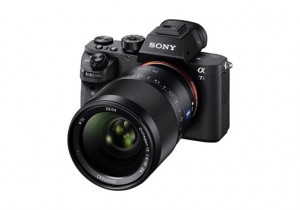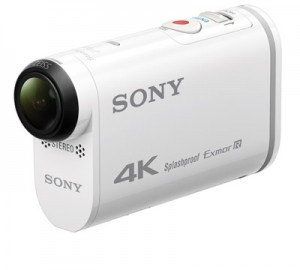
Neal Manowitz joined Sony in 1993, working on video-based imaging products, and spent his first 10 years working on launches in new categories like Sony digital camcorders and Sony’s first digital camera. After spending the next 10 years in the home entertainment product space, he rejoined the Consumer Imaging group in 2013. He was recently promoted to vice president of Sales and Marketing, overseeing North America operations for Sony’s Consumer Imaging business.
I recently spoke with him about Sony’s bold initiatives in the market, his efforts behind the industry adopting the “mirrorless” naming convention and how Sony views the future.
JG: It happens to be a challenging time right now to take the helm of Sony’s Consumer Imaging business, but Sony seems to be aggressive on a number of fronts. Let’s start with the pro DSLR category that has historically been lead by Canon and Nikon.
NM: I think you’ll hear that a consistent theme for Sony is not about focusing on our competitors but focusing on the customer. For us, driving innovation to allow people to capture their world the way they intend is critical for us. Photographers have been able to capture things they’ve never been able to capture before. If we’re following our competition, we can never truly lead, or truly innovate.

Is there the notion that because of the products that Sony can deliver to pros that you can capture a foothold in that market?
We very much look at the ILC market as a single market. And then whether it’s a DSLR, mirrorless or whatever, the form factor becomes secondary. In terms of our approach to the pro market, we’re extremely invested, and we will continue to innovate aggressively in that space. We will definitely continue to support the E-mount business with new and innovative products, like our recent announcement of the A68 camera.
Sony has forged ahead in the mirrorless category with impressive results. Do you see that segment as eventually leading the imaging category?
We anticipate the growth in mirrorless to remain extremely strong. It’s clearly where the customers are. According to NPD, the mirrorless market is up 19% year over year, while the DSLR market is down 15%. Sony’s business is up 49%, and we’re being disruptive in the market. Our approach is to provide the best camera and experience possible with consumers by continuing to innovate. We’ve been very fortunate; the more the company is focused on imaging solutions, the better it is for consumers.
What is it about Sony products, or the Sony strategy, that make them disruptive in the market?
I would say it’s continuing to provide technology that other companies haven’t. For example, because of the sensor technology and other technology that we have, the a6000 offers the world’s fastest autofocus and the a7S Mark II turns night into day. And recently, with the A7R Mark II, which has already received many awards, the dynamic range and the capabilities make it stand out.

I know you were very passionate about the category adopting the mirrorless name, and I know it was controversial in the industry when people couldn’t get on the same page. What was the process like getting to the point where the term mirrorless was adopted and why was it so important?
With any new next-generation technology, there is a consumer education component. We saw it in High Def and Blu-ray, and we see it happening now in 4K. And it’s the same with mirrorless technology. We looked at it back in 2013 and saw a big disconnect between what the media, retailers, manufacturers and consumers were all calling the technology. We did a range of research, including end-user surveys and analyzing Google search terms, and found that consumers were already calling it mirrorless. But the fact is, there was a ton of confusion, and when there is confusion, consumers choose not to buy.
So to solve it, we went to the industry leaders at PMDA and CEA, and we went to our retail partners and to the media. And we came together as an industry and were able to agree that “mirrorless” was best from the consumer perspective. Without these organizations coming together, the industry would have stayed in a state of confusion. The result is we’re seeing that consumers are reacting with their dollars and we’re experiencing great increases—not only in sales but in the name awareness as well. So to the industry, and to you, thank you.
 That was an impressive coalition you put together, and it was important to the market. I applaud you as well. Are you seeing it being adopted in the market?
That was an impressive coalition you put together, and it was important to the market. I applaud you as well. Are you seeing it being adopted in the market?
It has happened. If you look at all of the major retailers out there, they have all shifted the terminology. Many used to call it compact system cameras, but now all major retailers have shifted over to mirrorless.
I know that initially the mirrorless category really took off in Japan, and a bit more quickly in Europe, but the U.S. seemed to lag behind a bit. Is the U.S. catching up?
The U.S. is now up to more than 20% mirrorless from 15% in 2013, so growth is happening, and it will continue. Initially in the U.S., there was a perception that a large camera meant a better camera. But as mirrorless technology evolved to exceed the performance of comparable DSLRs, the rate of change increased. So the cameras not only meet but also exceed the level that’s out there today. Take the a6000 or a7R Mark II, they capture images that could never be captured before, and they have features like 4K video capability. That’s what is driving adoption, and it gets the photographers excited. The fact that the cameras are smaller is a huge bonus, and one that is often talked about in the U.S. If you ask pro photographers to choose between quality or size, they’re going to go with quality. And what we’ve been able to provide is both.
Do you see more of the growth in mirrorless coming up from point and shoots, cameraphones and long-zoom compact cameras, or do you see it coming down from the DSLR user base?
Good question. There are a couple of interesting pieces. The simple answer is that it’s really an alternative, next-generation of DSLR, and another growth segment in this is the premium point-and-shoot market. While the point-and-shoot market has significantly declined, the most premium segment of point and shoots is not declining. So while the entry level is being taken over by mobile phones, photographers who care about images and really want the best quality are not running away from dedicated cameras. On the mirrorless side, we’re seeing the average selling prices increasing, and we’re seeing more adoption and acceptance at the higher price points versus the lower.
So it seems like more people are coming down from DSLRs, but they will start to come up from the premium compact camera as the cameras evolve.
I like to say they’re stepping up to a mirrorless camera from a DSLR.
Touché. I forgot to whom I was talking. What about the action camera segment? GoPro had a nice run in establishing the category. Do you see growth for other brands as well?
Again, from our standpoint, we’re not looking at it from a competitive perspective but, instead, from how we can excite the end customer. The action cam industry is very dynamic. We’ve seen double-digit declines over the last several months, and the category is also evolving. In the end, people want to capture their lives, and we need to capture their imagination with unique products. With amazing innovation happening

in the sensor business, it’s up to us as product planners and engineers to determine what will next capture the consumer imagination.
Smartphones: friend or foe?
Definitely friend, especially for Sony. As the dominant global sensor company that provides sensors for many mobile phones, it’s a big part of our company’s business. But also, the mobile phone provides a platform for sharing that has driven interest in photography more than ever before. Virtually all of our cameras have a variety of Wi-Fi capabilities built in that are pushing to make the connection between cameras and phones more seamless.
I think we can all agree that we haven’t really figured out how to make using Wi-Fi in cameras that seamless. So having the phone as a carrier is where most of the companies are ending up, right?
I don’t think cameras will ever replace the phone. We’ve seen the opposite, but as a camera manufacturer in the imaging space, this is a great thing. And the consumer trend is not going to stop. Next year’s cameraphones are going to be even that much better in terms of the images they can capture, and next year’s digital cameras are going to be that much better. So we need to continue to innovate to add value to the cameras. Ultimately, people will take more pictures next year and the year after, which provides the platform and the opportunity for the camera manufacturers to drive the business.
What can retailers do to better promote camera sales?
Number one, don’t focus on the negative trends in the market. They will continue, and the entry-level point-and-shoot market is going to continue to decline. But what they can do is focus on the growth and value they can provide. We’ve seen amazing innovation coming from our retail partners, and we’re seeing great success. One example of that is event-based marketing that brings customers in to educate them. Also, they should focus on who the right customer is. While the market is drastically increasing with the number of pictures being taken, we’re seeing a shift in the people who are buying the cameras. The enthusiasts and professionals who care about the pictures and videos they take, and the worlds they capture, will continue to become a more important segment of the market.
For us, it’s about building on the success of the mirrorless market, the premium digital still camera market, and the 4K camcorder market. Those are all growth areas to focus on.
Should retailers also be focusing on the younger market?
I think the good thing is that one size doesn’t fit all in the imaging space. You see this in other industries, but especially in the imaging space. There is no single one device and there is no single one customer, and from the retail side there’s the same thing. There are definitely opportunities, especially through event marketing and bringing customers in. You have this ability to have a more targeted approach to photographers.
Any other surprising kernels of truth for our readers?
Here are some surprising stats that tie into our conversation. In the analog world of photography in the late 1990s, we reached around 35 million cameras sold worldwide. In the digital age, the late 2000s, we were able to grow that to around 120 million cameras sold. Today, now looking at the mobile phone space and digital cameras and the few analog cameras still around, we’re at around 1.3 billion devices sold. People love capturing their world, and we need to capture their hearts and imaginations.
What keeps you up at night?
Our back orders and my bosses, in that order.
To see more of what is happening at Sony, visit their website, alphauniverse.com, and follow them on Instagram at sonyalpha.com.





